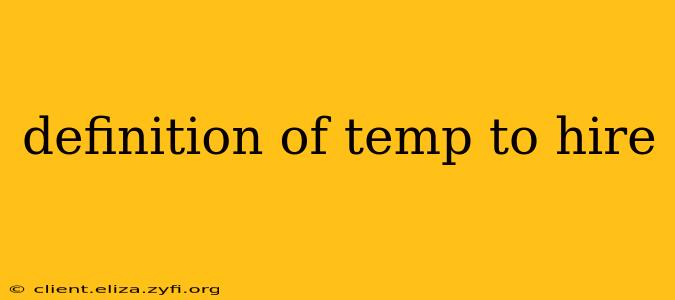Temp-to-hire, also known as temporary-to-permanent employment, is a staffing strategy where a company hires a temporary employee with the potential to transition into a full-time, permanent role. It's a win-win situation for both the employer and the employee, offering flexibility and a trial period before committing to a long-term arrangement. This detailed guide will explore the intricacies of temp-to-hire employment, addressing common questions and concerns.
What is the difference between temp and temp-to-hire?
The key difference lies in the intent and expectation. A temporary employee (or temp) is hired for a specific project, task, or period, with no guarantee of future employment. Their role has a defined end date. In contrast, temp-to-hire positions explicitly state the possibility of converting to a permanent role after a trial period. This trial period allows the employer to assess the employee's skills, performance, and cultural fit before making a long-term commitment. The employee also gets a chance to experience the company culture and determine if it's a good fit for their career goals.
How does a temp-to-hire position work?
Typically, a temp-to-hire arrangement starts with a temporary contract through a staffing agency or directly with the company. During this temporary phase, the employee works alongside permanent staff, performing the same or similar duties. Performance is closely monitored, usually with regular check-ins and performance reviews. After a predetermined period (often ranging from a few weeks to several months), the employer evaluates the employee's suitability for a permanent position. If both parties are satisfied, the temporary employee is offered a full-time, permanent position with benefits and increased responsibilities.
What are the advantages of temp-to-hire for employers?
Temp-to-hire offers significant advantages for companies:
- Reduced risk: Employers can assess a candidate's abilities and fit before committing to a long-term employment contract, minimizing the risk of a bad hire.
- Flexibility: It provides the ability to scale their workforce up or down depending on project needs.
- Cost-effectiveness: Temporary employees often don't receive the same benefits as permanent employees, reducing initial labor costs.
- Access to talent: Temp agencies can provide access to a wider pool of skilled candidates than traditional recruitment methods.
What are the advantages of temp-to-hire for employees?
For employees, temp-to-hire offers:
- Foot in the door: It provides an opportunity to gain experience within a company and demonstrate their skills, increasing the chances of securing a permanent position.
- Trial period: It allows employees to assess the company culture, work environment, and job responsibilities before committing to long-term employment.
- Immediate income: Provides immediate employment and income while offering the potential for a permanent role.
- Skill development: Allows for the development of new skills and experience that can boost their career prospects.
How long does a temp-to-hire assignment typically last?
The length of a temp-to-hire assignment varies depending on the role, company, and industry. It can range from a few weeks to several months, often averaging 3-6 months. The duration is usually outlined in the initial temporary contract.
What are the disadvantages of temp-to-hire for employers?
While advantageous, there are potential drawbacks:
- Administrative burden: Managing temporary employees can add administrative overhead.
- Potential for turnover: If the temporary employee doesn't convert to a permanent role, the company may have to repeat the hiring process.
- Training costs: Training costs may be incurred if the temporary employee doesn't transition to a permanent role.
What are the disadvantages of temp-to-hire for employees?
For employees, there are considerations:
- Uncertainty: There's no guarantee of a permanent position at the end of the temporary assignment.
- Limited benefits: Temporary employees often receive fewer benefits than permanent employees.
- Potential for exploitation: There is a risk of exploitation if the employer uses the temporary arrangement to avoid offering permanent employment and full benefits.
In conclusion, temp-to-hire employment offers a valuable solution for both employers and employees seeking a balanced approach to hiring and employment. By carefully weighing the advantages and disadvantages, both parties can maximize the benefits and minimize potential risks of this flexible employment strategy.
